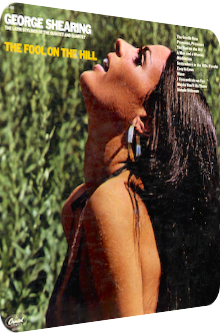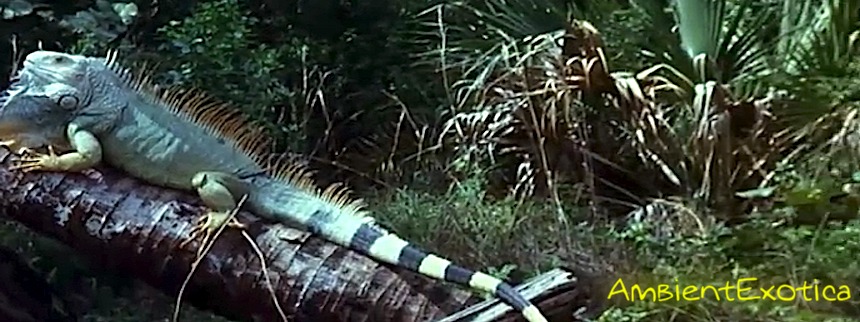
George Shearing
The Fool On The Hill
1969
Believe it or not, but The Fool On The Hill is what I would call an Exotica album regardless of the fact that it is released in 1969 and delivered by Bebop luminary, talented pianist and unusual suspect George Shearing (1919–2011). It is his final album for Capitol Records, comprising of eleven tracks in total, one of them written by Shearing himself, four of them played with a quintet, the others realized with the help of a quartet. The Fool On The Hill is a strange title for a sophisticated Jazz album and would have been devastating at the time of its release if this were George Shearing’s debut album: name one dead-serious and proud artist who would call himself a fool? Granted, the pianist is obviously not the fool in this case, and so the title invokes both the fear of – or hope for – a Beatles tribute album and the anticipation of an exotic panorama, a wide view over tropical hills and lush copses. It is the front artwork that points the potential listener to the right direction.
A tribute to 50’s Exotica and its beautiful coquettes which graced the front covers (most of them being embodied by Sandy Warner anyway), The Fool On The Hill does not let the listener down at all. It may not feature the abundance of patterns, instruments and segues, fair enough, but the blend of congas, triangles, vibes and a particularly soothing guitar in juxtaposition to Shearing’s piano make this a great corker! But something is strange: all other musicians remain unmentioned, an odd omission given that the George Shearing Quartet is quite famous. So why is the changing roster not mentioned? Is this just a cheap album made with session musicians? I will tell you over the course of this review, but rest assured right now that The Fool On The Hill lives up to an Exotica fan’s hunting scheme… surprisingly so!
George Shearing’s staggering and most certainly inebriated piano chords open both the album and its first composition, Cole Porter’s Easy To Love whose uplifting staccato physiognomy makes for a great Latin Jazz transmutation. And indeed, once the overly eupeptic introduction is backed by argentine conga catenae, crystalline cymbals and a Balearic guitar setting in the background, the quartet suddenly vaporizes exotic erethism not unlike the nocturnal cataracts of the Rene Paulo Group. The Gentle Rain by Luiz Bonfá and Matt Duby meanwhile presents the skills of George Shearing’s quintet and showcases the wonderfully pristine ambiance of a rainforest thanks to the downtempo maraca veils and contemplative piano mélange oscillating between nostalgia and thankfulness, whereas Antonio Carlos Jobim’s classic Wave sees the quartet dropping gorgeous rhythm guitar-accompanied splashes of sparkling melodies and cocktail visions near the ocean, with the follow-up I Concentrate On You by Cole Porter taking the very tonality and ameliorating it with clanging tom-toms and stupefying guitar movements which encapsulate the warmth and majesty of a sunset. Very catchy and vitreous!
Promises, Promises by Burt Bacharach and Hal David then allows the quintet to return with a rather eclectic helix of piano prongs, vibraphone sparks and revved up hi-hats, although the melody and interdependence remain king in this arrangement. Side A is then rounded off with Rube Bloom’s and Sammy Gallop’s Maybe You’ll Be There, another resurrection of the afternoon insouciance in a jungle: George Shearing remains in the spotlight, but it is the mellow guitar aorta that prevents this piece from being perceived as a Jazz cellar ode by the numbers, letting this tune seem to step out into the open air instead.
Antonio Carlos Jobim is also considered on side B: Meditation amplifies the omnipresence of the guitar and brings it into the foreground where it is a fitting foil to George Shearing’s refreshingly saltatory yet accessible tone fusillades. The Latin percussion is quite a bit crunchier as well and adds that important aura to the tune so that it comes ever closer to the Exotica nucleus. The third song played by the quintet is the second song of side B, namely A Man And A Woman by Francis Lai, Jerry Keller and Pierre Barouh. The timbre of this gold standard is different enough to stand out, for the heterodyned piano and guitar are hued in a syringa aurora that is so soothing and verdured that this could well be perceived as a late Martin Denny interpretation… without the textural overabundance that graces his 50’s albums. Still, this is a great rendition indeed.
Shearing’s own Simple Sideman follows next, a swinging Post Bop rascal loaded with a drier, more acidic guitar accompaniment and the expected stop-and-go whirls on the piano, with the eponymous Beatles classic The Fool On The Hill being taken by the quintet to jazzier climes. The singalong qualities are embraced, the amplified drums and snares evoke that Rock countermovement and make this one of the better Beatles tributes out there. George Shearing ends the LP in the same undulating spot: the hillside. Somewhere In The Hills by Antonio Carlos Jobim, Ray Gilbert and Vinicius De Moraes finishes the album’s exotic endemics with conga coppices, dreamy doldrums and hammock-friendly midtempo chords that are neither too complex nor quirky and therefore round off a surprisingly silky work of Latin rhizomes.
The Fool On The Hill is literally on the verge of changing times, towering above the tides and music-related revolutions that happen far below in the valleys. These times are exciting, the Space-Age movement is just about to reach its technocratic conclusion with the societal endpoint called Moon. These are the surroundings George Shearing’s album is embedded in, but not influenced by. It is a streamlined, dedicated artifact of Latin Jazz and Post Bop, however, due to the textural cross-linkage and enchanting euphony, The Fool On The Hill comes pretty close to the genre alloy called Exotica. If just a few birdcalls were scattered over this release, the perception would have largely changed! Even without the appearance of our plummeted friends, the material is successfully morphed and wondrously retrogressive from today’s viewpoint. The dialog between the piano and guitar is always leading to a tropical haze, especially so on The Gentle Rain and its alluring aureoles. Classics such as Wave are equally well represented, having memorable melodies to begin with which are further interpolated by the guitar’s sun-dappled radiance.
If the rose-tinted glasses are taken off for a moment, some potentially dubious things come to light: why the names of the involved participants remain unmentioned is not entirely beyond me. Certain clues are found in Shearing’s biography. The omitted names exude the odor of an accidental session musician setup that happened by chance and could well be interpreted as the first signs of a certain fatigue George Shearing felt in coming up with arrangements for the collective. Shearing found new success in the 70’s when he changed his attitude and the kind of material he played. In 1969, The Fool On The Hill is a boring bland of aural sermons, the inclusion of The Beatles notwithstanding. In hindsight, however, and from today’s viewpoint, this album is one of George Shearing’s breeziest, almost Exotica-worthy entries and therefore worth hunting down. It has not been reissued digitally as of yet, but a few songs are found on Shearing compilations. The vinyl version is luckily easy to catch at the usual market places and for a fair price.
Exotica Review 413: George Shearing – Fool On The Hill (1969). Originally published on Feb. 7, 2015 at AmbientExotica.com.
